Thermal Decomposition Kinetics and Compatibility of 3,5-difluoro-2,4,6-trinitroanisole (DFTNAN)
Abstract
:1. Introduction
2. Experimental
2.1. Materials
2.2. Preparation of Samples
2.3. Characterization
3. Results and Discussion
3.1. Thermal Decomposition Behavior of DFTNAN
3.1.1. DSC Analysis
3.1.2. TG Analysis
3.1.3. Non-Isothermal Decomposition Kinetics
3.1.4. Thermodynamic Parameters of Activation Reaction
3.1.5. Thermal Safety Parameters
3.2. Compatibility
3.2.1. DFTNAN/RDX
3.2.2. DFTNAN/HMX
3.2.3. DFTNAN/CL-20
3.2.4. DFTNAN/TKX-50
4. Conclusions
Author Contributions
Funding
Institutional Review Board Statement
Informed Consent Statement
Data Availability Statement
Acknowledgments
Conflicts of Interest
References
- Li, Y.; Yuan, J.M.; Zhao, W.; Qu, Y.; Xing, X.W.; Meng, J.W.; Liu, Y.C. Application and Development of 3,4-Bis(3-nitrofurazan-4-yl)furoxan (DNTF). Russ. J. Gen. Chem. 2021, 91, 445–455. [Google Scholar] [CrossRef]
- Ou, Y.X. Explosives; Beijing Institute of Technology Press: Beijing, China, 2014; pp. 387–388. ISBN 978-7-5640-8621-3. [Google Scholar]
- Agrawal, J.P.; Hodgson, R.D. Organic Chemistry of Explosives; John Wiley & Sons: Chichester, UK, 2006. [Google Scholar]
- Anniyappan, M.; Talawar, M.B.; Sinha, R.K.; Murthy, K.P.S. Review on Advanced Energetic Materials for Insensitive Munition Formulations. Combust. Explos. Shock. Waves 2020, 56, 495–519. [Google Scholar] [CrossRef]
- Vijayalakshmi, R.; Radhakrishnan, S.; Shitole, P.; Pawar, S.J.; Mishra, V.S.; Garg, R.K.; Talawar, M.B.; Sikder, A.K. Spherical 3-nitro-1,2,4-triazol-5-one (NTO) based melt-cast compositions: Heralding a new era of shock insensitive energetic materials. RSC Adv. 2015, 5, 101647–101655. [Google Scholar] [CrossRef]
- Smith, M.W.; Lu, J.P. Aging of the Insensitive Explosive, ARX-4024; DSTO Systems Sciences Laboratory: Edinburgh, UK, 2004. [Google Scholar]
- Hang, G.-Y.; Yu, W.-L.; Wang, T.; Wang, J.-T.; Li, Z. Comparative studies on structures, mechanical properties, sensitivity, stabilities and detonation performance of CL-20/TNT cocrystal and composite explosives by molecular dynamics simulation. J. Mol. Model. 2017, 23, 281. [Google Scholar] [CrossRef]
- Meng, J.-J.; Luo, Y.-M.; Niu, G.-T.; Wang, H.-X.; Yang, F. Effect of additives on the interface binding strength of DNAN/HMX melt-cast explosives. J. Energ. Mater. 2020, 38, 467–482. [Google Scholar] [CrossRef]
- Mishra, V.; Vadali, S.; Bhagat, A.; Garg, R.; Kugaonkar, V.; Subramanian, R.; Sinha, R.; Asthana, S. Studies on NTO-, FOX-7- and DNAN-based Melt Cast Formulations. Central Eur. J. Energ. Mater. 2017, 14, 403–417. [Google Scholar] [CrossRef]
- Ou, Y.X.; Han, T.J.; Rui, J.H.; Zhao, Y. High Energy Materials; National Defense Industry of Press: Beijing, China, 2013; pp. 85, 86, 140. ISBN 978-7-118-08692-8. [Google Scholar]
- Yang, R.; Dong, Z.; Ye, Z. Tetrazolium Nitrate Anion Based Salts as Potential Melt-Castable Explosives. ChemistrySelect 2019, 4, 14208–14213. [Google Scholar] [CrossRef]
- Wang, H.X.; Wang, X.F.; Luo, Y.M. Research Status and Development Trend of Insensitive Melt-Cast Explosive. Explos. Mater. 2021, 50, 4–12. [Google Scholar] [CrossRef]
- Tang, W.Q.; Ren, H.; Jiao, Q.J.; Zheng, W. Property Characterization of 3,4-Dinitropyrazole and its Application. Chin. J. Energ. Mater. 2017, 25, 44–48. [Google Scholar] [CrossRef]
- Hervé, G.; Roussel, C.; Graindorge, H. Selective Preparation of 3,4,5-Trinitro-1H-Pyrazole: A Stable All-Carbon-Nitrated Arene. Angew. Chem. 2010, 122, 3245–3249. [Google Scholar] [CrossRef]
- Anniyappan, M.; Varma, K.V.; Amit, R.; Nair, J. 1-methyl-2,4,5-trinitroimidazole (MTNI), a melt-cast explosive: Synthesis and studies on thermal behavior in presence of explosive ingredients. J. Energetic Mater. 2019, 38, 111–125. [Google Scholar] [CrossRef]
- Lian, P.-B.; Chen, J.; Chen, L.-Z.; Zhao, C.-Y.; Wang, J.-L.; Shen, F.-F. Preparation of 1-methyl-2,4,5-trinitroimidazole from derivatives of 1-methylimidazole and its oxidation under nitration conditions. Chem. Heterocycl. Compd. 2020, 56, 55–59. [Google Scholar] [CrossRef]
- Li, X.; Wang, B.-L.; Lin, Q.-H.; Chen, L.-P. Compatibility Study of DNTF with Some Insensitive Energetic Materials and Inert Materials. J. Energetic Mater. 2016, 34, 409–415. [Google Scholar] [CrossRef]
- Price, D.; Morris, J. Synthesis of DNMT: A New Energetic Melt-pour Ingredient. In Proceedings of the Insensitive Munitions and Energetic Materials Technology Symposium, Munich, Germany, 11–13 October 2010. [Google Scholar]
- Altenburg, T.; Klapötke, T.M.; Penger, A. Primary nitramines related to nitroglycerine: 1-nitramino-2,3-dinitroxypropane and 1,2,3-trinitraminopropane. Cent. Euro. J. Energ. Mater. 2009, 6, 255–275. [Google Scholar]
- Jing, S.; Jiang, Z.; Jiao, Q.; Li, Z.; Liu, Y.; Yang, L. 3,5-difluoro-2,4,6-trinitroanisole: Promising melt-cast insensitive explosives instead of TNT. J. Energ. Mater. 2021, 1–12. [Google Scholar] [CrossRef]
- Hu, Y.F.; Gu, W.B.; Liu, J.Q.; Wang, H.X.; Huang, H.; Xu, J.L. Numerical study on Propagation of Stress Wave in Aluminum Foam Sandwiched Plates. Explo. Mater. 2014, 43, 21–25. [Google Scholar] [CrossRef]
- Kissinger, H.E. Reaction Kinetics in Differential Thermal Analysis. Anal. Chem. 1957, 29, 1702–1706. [Google Scholar] [CrossRef]
- Ozawa, T. A New Method of Analyzing Thermogravimetric Data. Bull. Chem. Soc. Jpn. 1965, 38, 1881–1886. [Google Scholar] [CrossRef] [Green Version]
- Xiao, L.-B.; Zhao, F.-Q.; Luo, Y.; Li, N.; Gao, H.-X.; Xue, Y.-Q.; Cui, Z.-X.; Hu, R.-Z. Thermal behavior and safety of dihydroxylammonium 5,5′-bistetrazole-1,1′-diolate. J. Therm. Anal. Calorim. 2015, 123, 653–657. [Google Scholar] [CrossRef]
- Zhang, S.; Zhang, J.; Kou, K.; Jia, Q.; Xu, Y.; Liu, N.; Hu, R. Standard Enthalpy of Formation, Thermal Behavior, and Specific Heat Capacity of 2HNIW·HMX Co-crystals. J. Chem. Eng. Data 2018, 64, 42–50. [Google Scholar] [CrossRef]
- Liu, Y.; Jiang, Y.-T.; Zhang, T.-L.; Feng, C.-G.; Yang, L. Thermal kinetic performance and storage life analysis of a series of high-energy and green energetic materials. J. Therm. Anal. Calorim. 2014, 119, 659–670. [Google Scholar] [CrossRef]
- Yi, J.-H.; Zhao, F.-Q.; Wang, B.-Z.; An, T.; Wang, Y.; Gao, H.-X. BTATz–HNIW–CMDB propellants. J. Therm. Anal. Calorim. 2013, 115, 1227–1234. [Google Scholar] [CrossRef]
- Yan, Q.-L.; Xiao-Jiang, L.; La-Ying, Z.; Ji-Zhen, L.; Hong-Li, L.; Zi-Ru, L. Compatibility study of trans-1,4,5,8-tetranitro-1,4,5,8-tetraazadecalin (TNAD) with some energetic components and inert materials. J. Hazard. Mater. 2008, 160, 529–534. [Google Scholar] [CrossRef] [PubMed]
- De Klerk, W.P.C.; Schrader, M.A.; Van Der Steen, A.C. Compatibility Testing of Energetic Materials, Which Technique? J. Therm. Anal. Calorim. 1999, 56, 1123–1131. [Google Scholar] [CrossRef]
- Muravyev, N.V.; Monogarov, K.; Asachenko, A.F.; Nechaev, M.S.; Ananyev, I.V.; Fomenkov, I.V.; Kiselev, V.; Pivkina, A. Pursuing reliable thermal analysis techniques for energetic materials: Decomposition kinetics and thermal stability of dihydroxylammonium 5,5′-bistetrazole-1,1′-diolate (TKX-50). Phys. Chem. Chem. Phys. 2016, 19, 436–449. [Google Scholar] [CrossRef]
- Lee, J.-S.; Hsu, C.-K.; Chang, C.-L. A study on the thermal decomposition behaviors of PETN, RDX, HNS and HMX. Thermochim. Acta 2002, 392–393, 173–176. [Google Scholar] [CrossRef]
- Kimura, J.; Kubota, N. Thermal Decomposition Process of HMX. Propellants Explos. Pyrotech. 1980, 5, 1–8. [Google Scholar] [CrossRef]
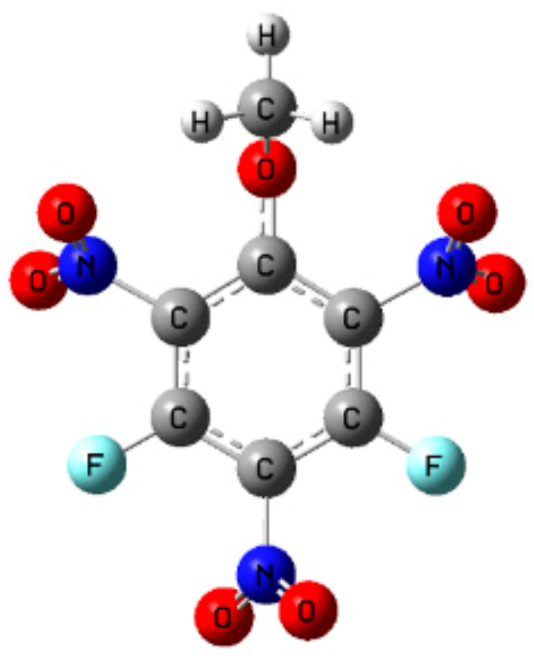


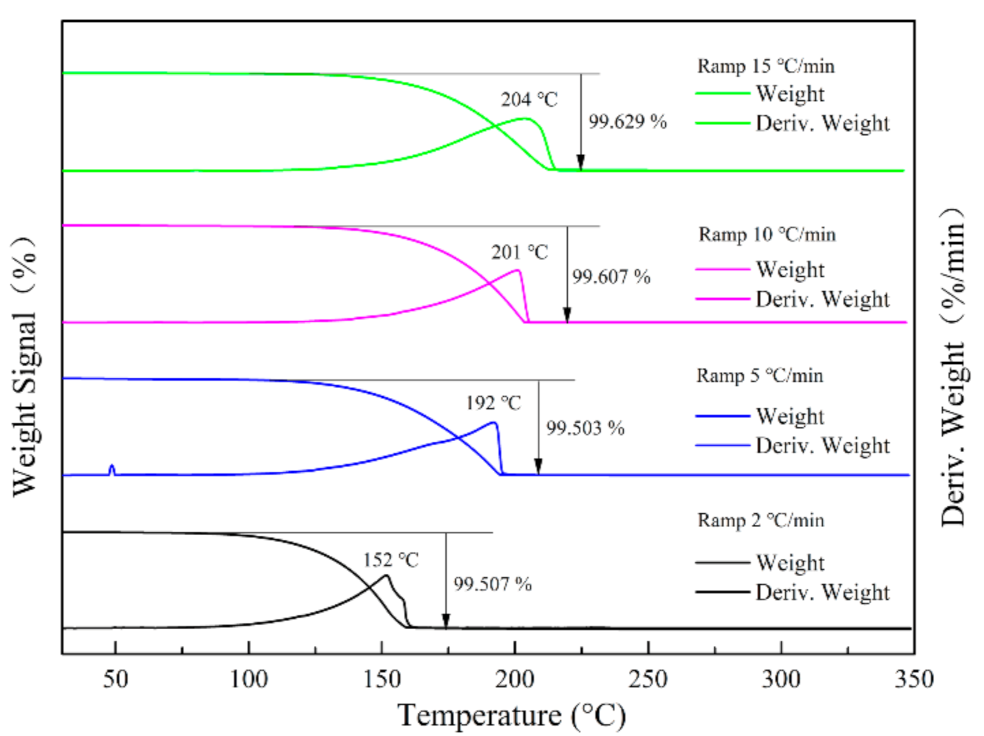
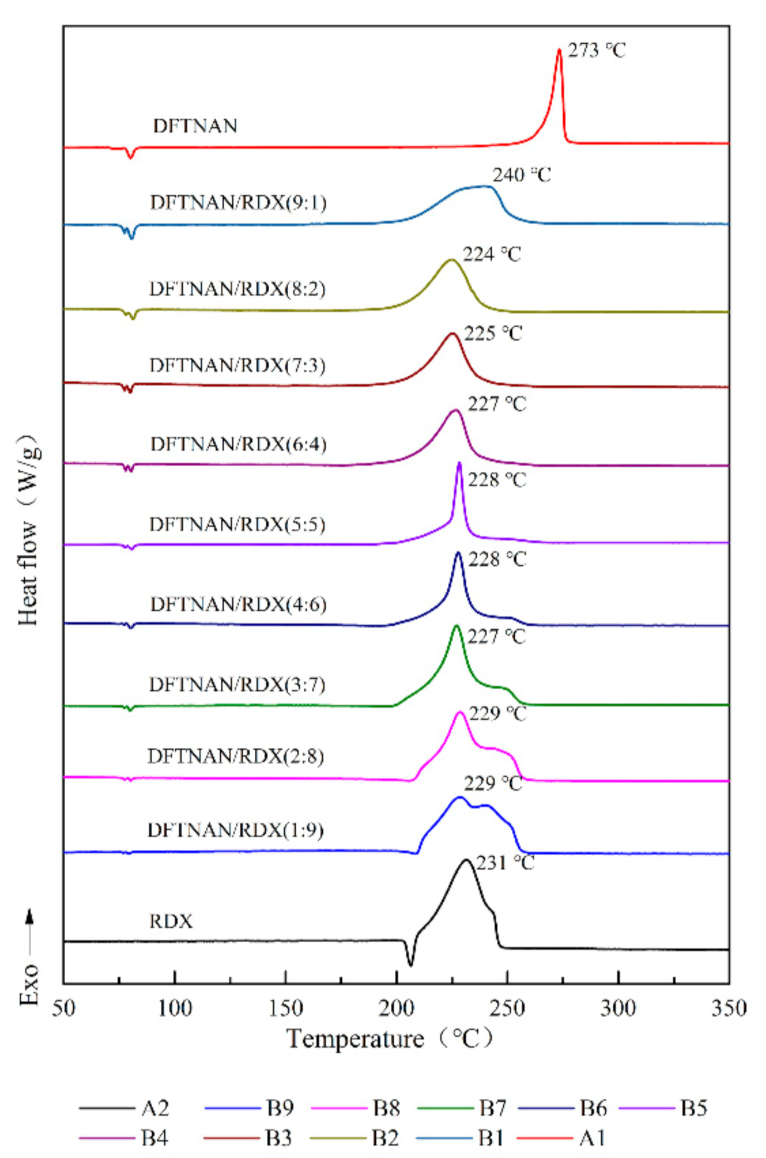
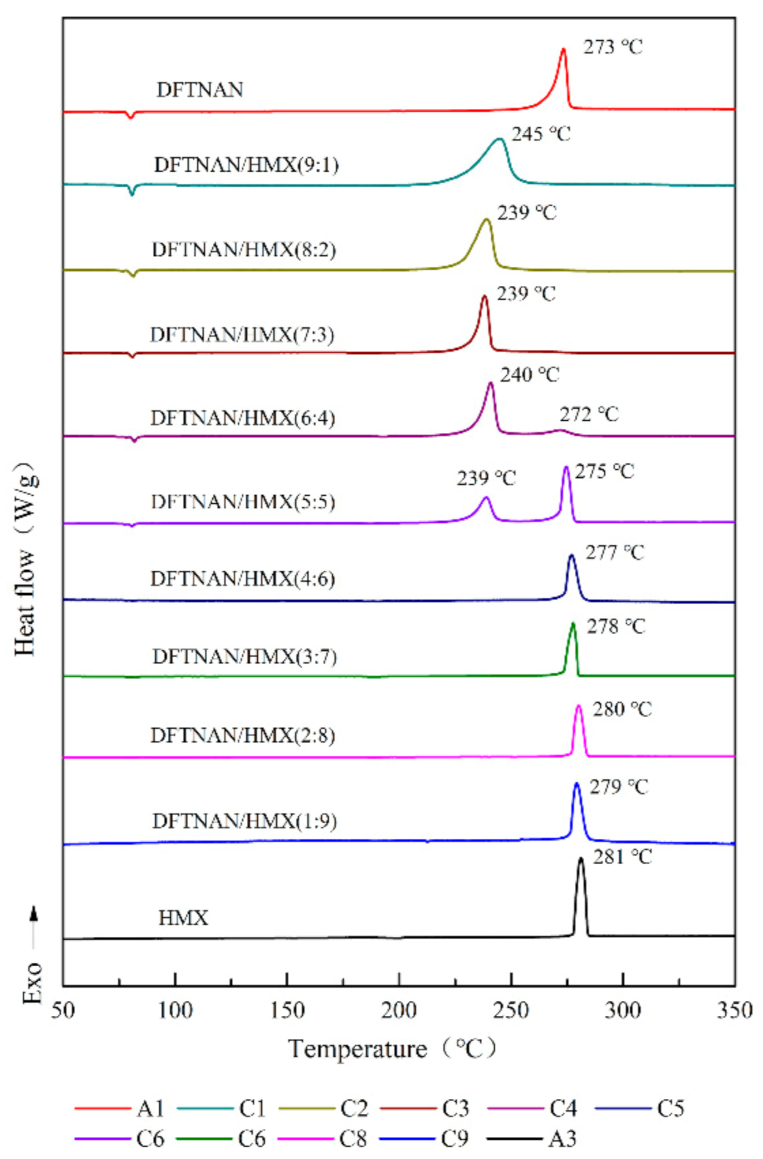
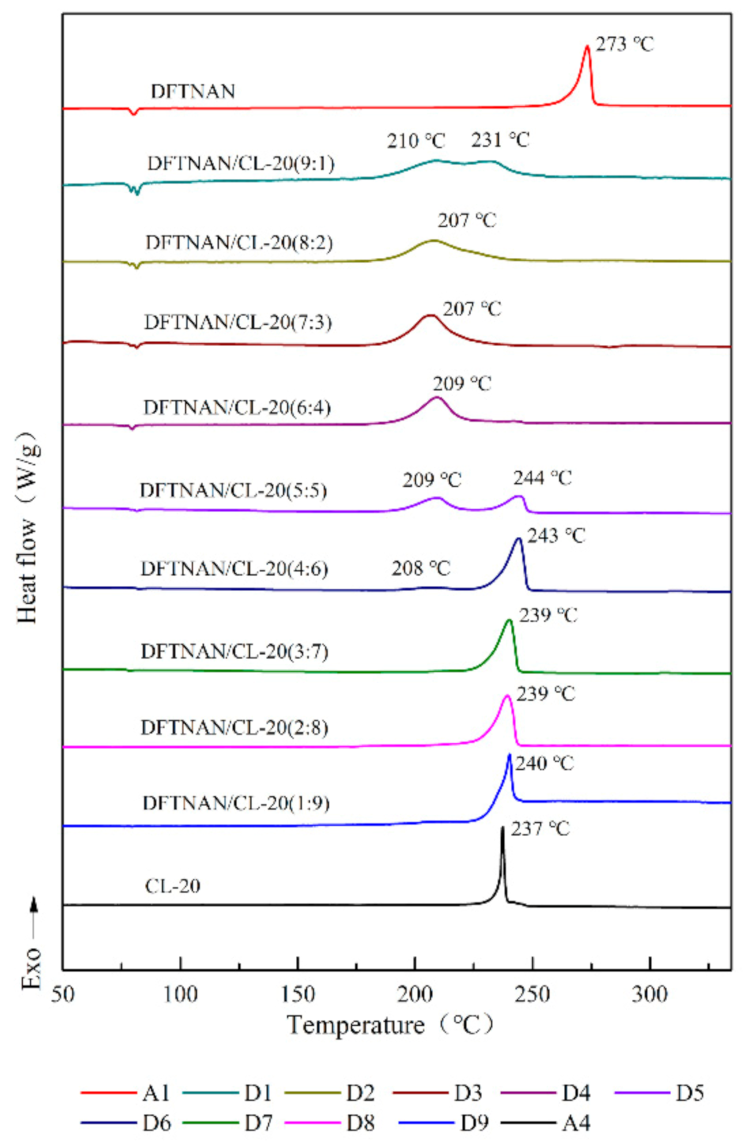
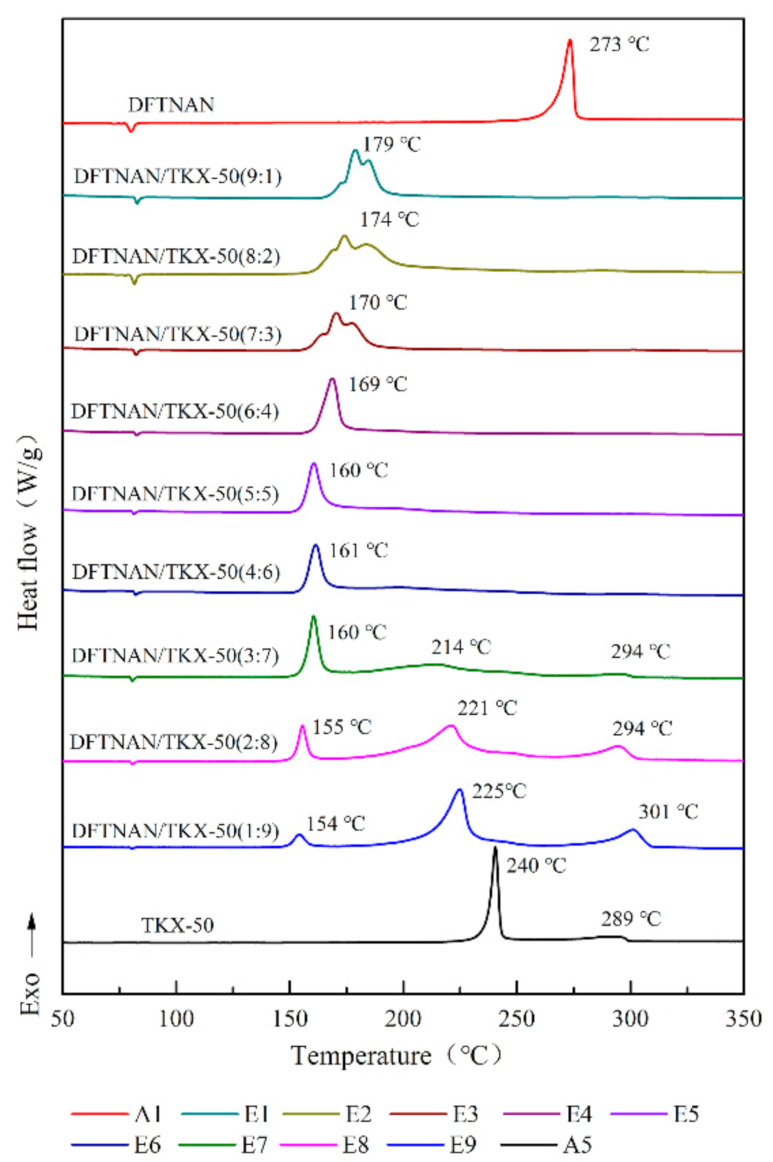
| Test Sample | Number | Test Sample | Number | ||||||||
|---|---|---|---|---|---|---|---|---|---|---|---|
| Single System | Mixture System | Mass Ratio (%) | |||||||||
| 9:1 | 8:2 | 7:3 | 6:4 | 5:5 | 4:6 | 3:7 | 2:8 | 1:9 | |||
| DFTNAN | A1 | DFTNAN/RDX | B1 | B2 | B3 | B4 | B5 | B6 | B7 | B8 | B9 |
| RDX | A2 | DFTNAN/HMX | C1 | C2 | C3 | C4 | C5 | C6 | C7 | C8 | C9 |
| HMX | A3 | DFTNAN/CL-20 | D1 | D2 | D3 | D4 | D5 | D6 | D7 | D8 | D9 |
| CL-20 | A4 | DFTNAN/TKX-50 | E1 | E2 | E3 | E4 | E5 | E6 | E7 | E8 | E9 |
| TKX-50 | A5 | / | |||||||||
| β/°C·min−1 | T’eo/°C | Tp/°C | Tf/°C |
|---|---|---|---|
| 2 | 246.20 | 251.64 | 255.41 |
| 5 | 266.63 | 272.59 | 275.76 |
| 10 | 285.45 | 289.72 | 295.12 |
| 15 | 291.17 | 297.99 | 304.02 |
| Kissinger’s Method | Ozawa’s Method | TASDT/°C | Tb/°C | ΔH≠/ kJ·mol−1 | ΔS≠/ kJ·mol−1·K−1 | ΔG≠/ kJ·mol−1 | |||
|---|---|---|---|---|---|---|---|---|---|
| Ak/min−1 | Ek/kJ·mol−1 | R2 | Eo/kJ·mol−1 | R2 | |||||
| 4.73 × 108 | 97.93 | 0.9977 | 101.78 | 0.9980 | 226.33 | 249.03 | 95.28 | −92.26 | 146.13 |
| Criteria △Tp (°C) | Content |
|---|---|
| <4 | -the mixture is considered to be compatible |
| 4–20 | -the mixture is considered “moderately” incompatible (it is necessary to apply other methods of determining the compatibility); |
| >20 | -the mixture is considered to be incompatible |
| System | Mass Ratios of Mixture | OB/% | Tp/°C | ΔTp/°C | Compatibility Judgment |
|---|---|---|---|---|---|
| DFTNAN | / | −43.01 | 273 | / | / |
| RDX | / | −21.62 | 231 | / | / |
| DFTNAN/RDX | 90:10 | −40.87 | 240 | 9 | “Moderately” incompatible |
| 80:20 | −38.73 | 224 | 7 | “Moderately” incompatible | |
| 70:30 | −36.59 | 225 | 6 | “Moderately” incompatible | |
| 60:40 | −34.46 | 227 | 4 | Compatible | |
| 50:50 | −32.32 | 228 | 3 | Compatible | |
| 40:60 | −30.18 | 228 | 3 | Compatible | |
| 30:70 | −28.04 | 227 | 4 | Compatible | |
| 20:80 | −25.90 | 229 | 2 | Compatible | |
| 10:90 | −23.76 | 229 | 2 | Compatible | |
| HMX | / | −21.62 | 281 | / | / |
| DFTNAN/HMX | 90:10 | −40.87 | 245 | 28 | Incompatible |
| 80:20 | −38.73 | 239 | 34 | Incompatible | |
| 70:30 | −36.59 | 239 | 34 | Incompatible | |
| 60:40 | −34.46 | 240,272 | 33,9 | Incompatible | |
| 50:50 | −32.32 | 239,269 | 34,12 | Incompatible | |
| 40:60 | −30.17 | 277 | 4 | Compatible | |
| 30:70 | −28.04 | 277 | 3 | Compatible | |
| 20:80 | −25.90 | 279 | 1 | Compatible | |
| 10:90 | −23.76 | 279 | 2 | Compatible | |
| CL-20 | / | −10.96 | 237 | / | / |
| DFTNAN/CL-20 | 90:10 | −39.81 | 210,231 | 24,42 | Incompatible |
| 80:20 | −36.60 | 207 | 66 | Incompatible | |
| 70:30 | −33.40 | 207 | 66 | Incompatible | |
| 60:40 | −30.19 | 209 | 63 | Incompatible | |
| 50:50 | −26.98 | 209,244 | 64,7 | Incompatible | |
| 40:60 | −23.78 | 208,243 | 65,6 | Incompatible | |
| 30:70 | −20.57 | 239 | 2 | Compatible | |
| 20:80 | −17.37 | 239 | 2 | Compatible | |
| 10:90 | −14.16 | 240 | 3 | Compatible | |
| TKX-50 | / | −27.12 | 240,289 | / | / |
| DFTNAN/TKX-50 | 90:10 | −41.42 | 179 | 94 | Incompatible |
| 80:20 | −39.83 | 174 | 99 | Incompatible | |
| 70:30 | −38.24 | 170 | 103 | Incompatible | |
| 60:40 | −36.65 | 169 | 104 | Incompatible | |
| 50:50 | −35.06 | 160 | 113 | Incompatible | |
| 40:60 | −33.48 | 161 | 112 | Incompatible | |
| 30:70 | −31.89 | 160,214,294 | 113,265 | Incompatible | |
| 20:80 | −30.30 | 155,221,294 | 118,195 | Incompatible | |
| 10:90 | −28.71 | 154,225,301 | 1,191,512 | Incompatible |
Publisher’s Note: MDPI stays neutral with regard to jurisdictional claims in published maps and institutional affiliations. |
© 2021 by the authors. Licensee MDPI, Basel, Switzerland. This article is an open access article distributed under the terms and conditions of the Creative Commons Attribution (CC BY) license (https://creativecommons.org/licenses/by/4.0/).
Share and Cite
Hu, F.; Wang, L.-J.; Zhao, W.; Liu, Y.-C.; Jing, S.-M.; Liu, P.; He, J.-X. Thermal Decomposition Kinetics and Compatibility of 3,5-difluoro-2,4,6-trinitroanisole (DFTNAN). Materials 2021, 14, 4186. https://doi.org/10.3390/ma14154186
Hu F, Wang L-J, Zhao W, Liu Y-C, Jing S-M, Liu P, He J-X. Thermal Decomposition Kinetics and Compatibility of 3,5-difluoro-2,4,6-trinitroanisole (DFTNAN). Materials. 2021; 14(15):4186. https://doi.org/10.3390/ma14154186
Chicago/Turabian StyleHu, Fei, Lin-Jian Wang, Wei Zhao, Yu-Cun Liu, Su-Ming Jing, Ping Liu, and Jin-Xuan He. 2021. "Thermal Decomposition Kinetics and Compatibility of 3,5-difluoro-2,4,6-trinitroanisole (DFTNAN)" Materials 14, no. 15: 4186. https://doi.org/10.3390/ma14154186






